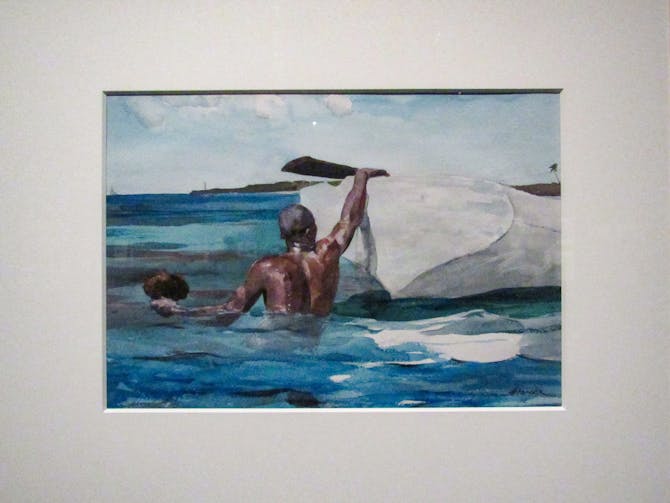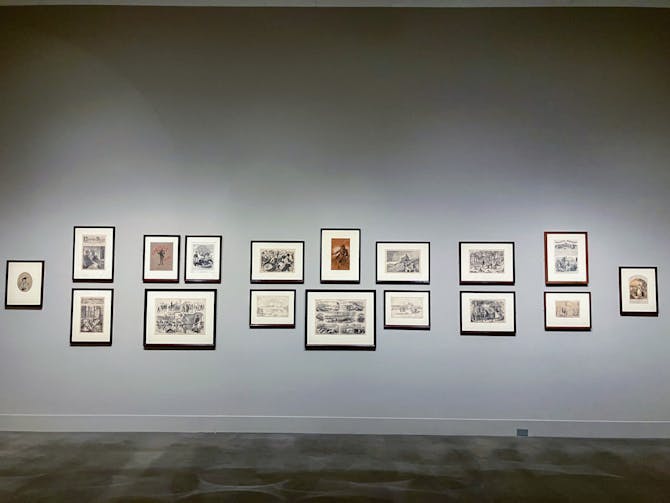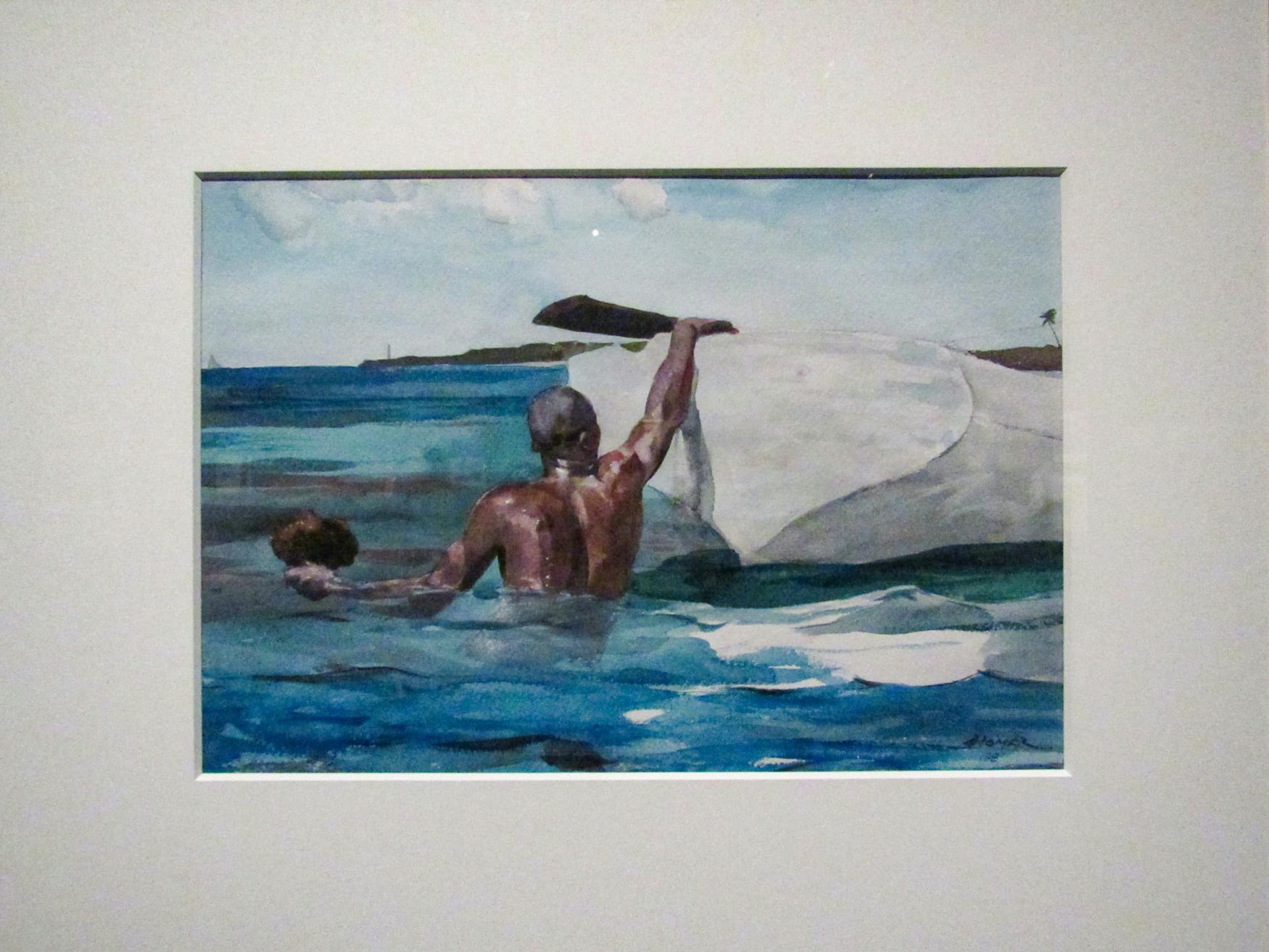Watercolors of Winslow: new Glance into the Waters of the Past
Opening this past Sunday at the Museum of Fine Arts in Boston, “Of Light and Air: Winslow Homer in Watercolor” is the largest exhibition of this gentle American giant’s unique watercolor compositions in almost half a century. Due to conservation concerns, these works must be rarely viewed, preserving sensitive pigments and details that would otherwise be lost to time. This is a true once in a lifetime experience, one I highly encourage all readers to take.
Homer’s watercolors are a deep study into the formal but also narrative aspects of representation. The MFA brilliantly presented the painter’s formal history; indeed, the work of curators Christina Michelon and Ethan Lasser cannot be truly understood without seeing the paintings firsthand. Beyond the medium’s stylistic and technical experimentation, I would like to discuss a provocative narrative that has been posthumously attributed to Homer. As an American artist working in the 19th and 20th centuries, Homer continually engaged with the Civil War, emancipation and social realism in his work.
The exhibition does an incredible job at highlighting the beginning of Homer as a Union-allied wartime artist whose work depicts the Black figure outside of caricature and present in the quotidian of camp life.

Winslow Homer, "Driftwood" (1908).
“Life in Camp, Part 2: In the Trenches” (1864) shows an ink-wash muscular Black man at work in the trenches of the Union war fields, marking a distinct moment of realism in the representation of the Black figure. While a more profound understanding of emancipation will clearly show that his vision of Blackness is still deeply rooted in the 19th century, this print not only expresses Homer’s penchant for revolutionary change, but also how medium reflected such willingness to develop.

Winslow Homer, "The Sponge Diver" (1898-99).
Watercolor and ink washing share unique similarities due to the fluidity necessary of their technique. The watercolors are Homer’s medium for these looser narratives and pictures of life; they depict human beings in soft colors, a stark shift from his dramatic oil compositions. This distinction is incredibly important to Homer’s work as such fluidity and imprecision forces the artist into a more continual and changing state of mind.
Such ideas of humanity in a post-war reconstruction would lead him around the nation to depict the pastoral bucolic life of America. While this was a common theme for his many watercolors, it should be mentioned that he did not shy away from difficult realities in oil at this time period. Rather, as his watercolors took up technical qualities of his oil painting, we see him begin to mix narrative and medium. Ephemeral moments of wind, light and humanity slowed to a brief instance of pigment soaking the picture until such temporality becomes permanent.

Collections of Civil War prints by Homer.
The exhibition clearly shows the deep intellectual effort that Homer exhibits in such pieces. His work in watercolor plays into narrative through its discursive materiality. As watercolor traditionally is seen as less permanent, less expensive and less impactful for the public, these paintings offer a true peek into the narratives that Homer was seeing, processing and desired to expose. These narratives often included people from varying backgrounds, including those he viewed and interacted with in his travels.
The later works in the galleries of the exhibition show these voyages through his watercolors well, but I believe the two most impactful are “The Sponge Diver” (1898-99) and “Montagnais Indians, Pointe Bleue, Quebec” (1895). Made during his travels across Canada and Bermuda, these works show valuable testimonies as Homer witnessed the humans of the areas at work. As one of the great American realist painters, Homer’s work was incredibly focused on the labor of human populations he interacted with. As he depicted these people, their labor became not just the subject but the worthy subtext of the viewer. The audience sees and recognizes the value of the human hands at work as the subject occupies the feathered brushstrokes of Homer’s watercolors.
“The Sponge Diver” shows the soft and languid musculature of an emerging diver whose skin glistens with light from the harsh Bermuda sun. Warm blue waters flood the bottom register of the painting. Translucent waves lap and move as the audience sees the lower torso and forearm of the figure show through peaks and valleys. Soft shadows are cast throughout the composition, showing us the heat of the sun on the back of the figure. Turned away from the viewer, the figure’s anonymity signals that the personal subject is not the focus but rather the universality of the labor and the figure’s action. Diving for the sponge, this working man is immortalized in the pigment. It is these such compositions that inspired the philosopher Alain Locke to describe Homer as an American artist above his contemporaries for his unabashed anti-stereotypical representation of Black people (Locke, 1936, p. 45).

Winslow Homer, "Montagnais Indians, Pointe Bleue, Quebec" (1895).
“Montagnais Indians, Pointe Bleue, Quebec” is an earlier composition, yet reflects very similar ideas. In this composition, we see Indigenous women at work, presenting a uniqueness to this composition. In search of accurate representations, the MFA decided to bring in representatives from the Innu people to best describe the scene before us. The Innu people have traditionally carved these canoes, which Homer happened to witness in his travels to Quebec. In this composition, Homer’s work, in its anti-narrative, shows a true aspect of the Innu people that was supported by the representative to the MFA. As Homer depicts this tribe, he shows women as caretakers and carpenters, presenting the Innu outside of the traditional gender constructions. This forces the viewer to recognize the complex social relationships of the indigenous tribes of the Americas.
Ultimately, Homer’s decades of work in watercolor culminated in an essential corpus that offers the clearest understanding of the painter’s development. As the MFA has quoted, Homer agrees that “in the future, I will live by my watercolors,” expressing the personal sentimental aspect of this work, but maybe something deeper (Press Release). Perhaps Homer recognized that the future, and we ourselves, would view the watercolors as a further truth. As his soft pigments become truth and testimony, these compositions become deeply ingrained with the soul of the Americas and all its peoples.
— Correction: An earlier version of this article misspelled Winslow Homer’s name on first reference. It has since been corrected.



Please note All comments are eligible for publication in The Justice.